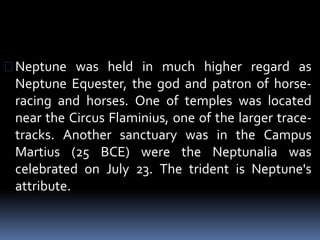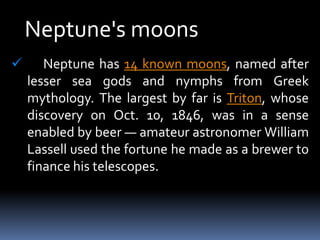Neptune
- 3. is the 8th planet from the Sun and the fourth largest (by diameter). is smaller in diameter but larger in mass than Uranus. NEPTUNE
- 4. orbit: 4,504,000,000 km (30.06 AU) from Sun diameter: 49,532 km (equatorial) mass: 1.0247e26 kg PLANET PROFILE
- 5. History of Neptune In Roman mythology, NEPTUNE - the god of the sea among the Romans. He was not a very powerful god, and little is known of his origin. When he was first introduced in Rome, he already had all the characteristics of the Greek Poseidon. Despite the fact that his cult grew after his equation with Poseidon, Neptune was far less popular among sailors than Poseidon was among the Greek mariners. Neptune was held in much higher regard as Neptune Equester, the god and patron of horse-racing and horses. One of temples was located near the Circus Flaminius, one of the larger trace- tracks. Another sanctuary was in the Campus Martius (25 BCE) were the Neptunalia was celebrated on July 23. The trident is Neptune's attribute.
- 6. Poseidon from Milos, 2nd century BC (National Archaeological Museum of Athens) Abode Mount Olympus, or the Sea Symbol Trident, fish, dolphin, horse and bull Consort Amphitrite Parents Cronus and Rhea Siblings Hades, Demeter, Hestia,He ra, Zeus Children Theseus,Triton,Polyphemu s, Belus,Agenor, Neleus,Atl as Roman equivalent Neptune
- 7. Neptune was held in much higher regard as Neptune Equester, the god and patron of horse- racing and horses. One of temples was located near the Circus Flaminius, one of the larger trace- tracks. Another sanctuary was in the Campus Martius (25 BCE) were the Neptunalia was celebrated on July 23. The trident is Neptune's attribute.
- 8. RESEARCHERS: Galle, Johann Gottfried 1812-1910 German astronomer who, with Heinrich Louis d'Arrest, made the first observation of Neptune based on calculations by Le Verrier. Though Galle was the first to observe Neptune, its discovery is usually credited to Adams (who made an earlier calculation) and LeVerrier. d'Arrest, Heinrich Louis Danish astronomer who assisted Galle with the first observations of Neptune. After receiving its predicted position from Le Verrier, Galle and d'Arrest began searching. With Galle at the eyepiece and d'Arrest reading the chart, they scanned the sky and checked that each star seen was actually on the chart. Just a few minutes after their search began, d'Arrest cried out, "That star is not on the map!" and earned his place in the history books
- 9. RESEARCHERS: Adams, John Couch 1819-1892 English astronomer and mathematician who, at the age of 24, was the first person to predict the position of a planetary mass beyond Uranus. But, unfortunately, Adams did not publish his prediction.Galle confirmed the existence of Neptune based on independent calculations done by LeVerrier. LeVerrier, Urbain Jean Joseph 1811-1877 French mathematician whose prediction of the position of an undiscovered planet (Neptune) that caused perturbations in the orbit of Uranus was the first to be confirmed (by Galle) though Adams had made a similar but unpublished prediction some months earlier.
- 10. Galileo Galilei 1564-1642 Italian astronomer and physicist. The first to use a telescope to study the stars. Discoverer of the first moons of an extraterrestrial body (see above). Galileo was an outspoken supporter of Copernicus'sheliocentric theory. In reaction to Galileo, the Church declared it heresy to teach that the Earth MOVED and silenced him. RESEARCHERS:
- 11. Neptune's elliptical, oval-shaped orbit keeps the planet an average distance from the sun of almost 2.8 billion miles (4.5 billion kilometers), or roughly 30 times as far away as Earth, making it invisible to the naked eye. Neptune goes around the sun once roughly every 165 Earth years, and completed its first orbit, since being discovered, in 2011. Every 248 years, Pluto moves inside Neptune's orbit for 20 years or so, during which time it is closer to the sun than Neptune. Nevertheless, Neptune remains the farthest planet from the sun, since Pluto was reclassified as a dwarf planet in 2006. Orbital characteristics
- 12. Atmospheric composition (by volume): hydrogen, 80 percent; helium, 19.0 percent; methane, 1.5 percent Magnetic field: Roughly 27 times more powerful than Earth's Composition:The overall composition of Neptune is, by mass, thought to be about 25 percent rock, 60 to 70 percent ice, and 5 to 15 percent hydrogen and helium, according toTristan Guillot, author of "Interiors of Giant Planets Inside and Outside the Solar System" in the journal Science. Internal structure: Mantle of water, ammonia and methane ices; Core of iron and magnesium-silicate Composition & structure
- 13. Average distance from the sun: 2,795,084,800 miles (4,498,252,900 km). By comparison: 30.069 times farther than Earth Perihelion (closest approach to the sun): 2,771,087,000 miles (4,459,630,000 km). By comparison: 29.820 times that of Earth Aphelion (farthest distance from the sun): 2,819,080,000 miles (4,536,870,000 km). By comparison: 30.326 times that of Earth Orbit & rotation
- 14. Neptune has 14 known moons, named after lesser sea gods and nymphs from Greek mythology. The largest by far is Triton, whose discovery on Oct. 10, 1846, was in a sense enabled by beer — amateur astronomer William Lassell used the fortune he made as a brewer to finance his telescopes. Neptune's moons
- 15. Triton is the only spherical moon of Neptune — the planet's other 13 moons are irregularly shaped. It is also unique in being the only large moon in the solar system to circle its planet in a direction opposite to its planet's rotation — this "retrograde orbit" suggests that Triton may once have been a dwarf planet that Neptune captured rather than forming in place, according to NASA. Neptune's gravity is dragging Triton closer to the planet, meaning that millions of years from now, Triton will come close enough for gravitational forces to rip it apart.
- 16. Triton is extremely cold, with temperatures on its surface reaching about minus 391 degrees F (minus 235 degrees C), making it one of the coldest places in the solar system. Nevertheless, Voyager 2 detected geysers spewing icy matter upward more than 5 miles (8 km), showing its interior appears warm. Scientists are investigating the possibility of a subsurface ocean on the icy moon. In 2010, seasons were discovered onTriton.
- 17. In 2013, scientists working with SETI caught sight of Neptune's "lost" moon of Naiad using data from the Hubble Space Telescope. The 62- mile-wide (100 km) moon has remained unseen since Voyager 2 discovered it in 1989. Also in 2013, scientists using the Hubble Space Telescope found the 14th moon, dubbed S/2004 N 1. It is Neptune's smallest moon and is just 11 miles (18 km) wide. It got its temporary name because it is the first satellite (S) of Neptune (N) to be found from images taken in 2004, according to NASA. The rings of Neptune Neptune's unusual rings are not uniform, but possess bright thick clumps of dust called arcs. The rings are thought to be relatively young and short-lived. Earth-based observations announced in 2005 found that Neptune's rings are apparently far more unstable than previously thought, with some dwindling away rapidly, according to an article in the journal Icarus.
- 18. NASA's Voyager 2 satellite was the first and as yet only spacecraft to visit Neptune on Aug. 25, 1989. The satellite discovered Neptune's rings and six of the planet's moons — Despina, Galatea, Larissa, Naiad, Proteus and Thalassa. An international team of astronomers relying on ground telescopes announced the discovery of five new moons orbiting Neptune in 2003. Research & exploration
- 19. Neptune is generally thought to have formed with the initial buildup of a solid core followed by the capture of surrounding hydrogen and helium gas in the nebula surrounding the early sun. In this model, proto-Neptune formed over the course of 1 to 10 million years. Formation of Neptune
- 20. T HANK YOÜ Present by: Ma. Christine Joyce B. Arbes BEED-03



















